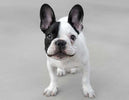
What French Bulldogs Were Bred For
, 5 min reading time

, 5 min reading time
French Bulldogs are one of the most popular companion dog breeds today, but their origins date back to the 19th century. Originally bred for companionship, these small yet sturdy dogs quickly became favorites among various social classes. In this article, we explore what French Bulldogs were bred for, their history, characteristics, and their role as companion animals.
The story of French Bulldogs begins in England, where they were initially bred as miniature Bulldogs. Their popularity grew among lace workers, who later migrated to France, bringing their dogs with them. Over time, the breed was refined in France, giving them the distinctive features we recognize today.
French Bulldogs originated from small-sized Bulldogs in England. Breeders aimed to create a more compact version that retained the Bulldog's affectionate and loyal nature while being better suited for smaller living spaces.
When English lace workers moved to France, they brought their small Bulldogs along. The breed quickly gained popularity, especially among the Parisian elite. French breeders refined their appearance, particularly emphasizing their signature bat-like ears.

French Bulldogs were primarily bred as companion animals, designed to provide comfort and emotional support. Unlike larger working dogs, their purpose was to be affectionate, friendly, and adaptable to different environments.
In the early days, French Bulldogs provided companionship to lace workers, offering both comfort and entertainment while they worked.
As their popularity grew in France, French Bulldogs became a symbol of status and were often seen with artists, intellectuals, and aristocrats.
French Bulldogs have unique physical and personality traits that make them stand out as excellent companion pets.
French Bulldogs were bred specifically to be human companions. Their loyalty and friendly nature make them excellent pets for individuals, families, and even seniors.
Whether living in a city apartment or a suburban home, French Bulldogs can adapt easily. Their low exercise requirements make them suitable for various owners.
French Bulldogs are often used as emotional support animals due to their intuitive ability to sense their owners’ emotions and provide comfort.
Owning a French Bulldog requires attention to their unique needs, including diet, exercise, and healthcare.
Since they are prone to obesity, maintaining a well-balanced diet is essential. Portion control and high-quality food tailored to their needs can help keep them healthy.
Although they enjoy playing, French Bulldogs do not require excessive exercise. Short walks and indoor playtime are usually sufficient.
Their short coat is low-maintenance, but regular brushing helps keep their skin healthy. Owners should also clean their facial wrinkles to prevent infections.

Like many purebred dogs, French Bulldogs are prone to certain health conditions.
Due to their flat faces, French Bulldogs often experience breathing difficulties, especially in hot weather or during excessive physical activity.
French Bulldogs can suffer from hip dysplasia, which affects their mobility and can lead to arthritis.
Their skin folds require regular cleaning to prevent irritation and infections. Many French Bulldogs also have food allergies that require dietary adjustments.
French Bulldogs have gained massive popularity in pop culture, often seen as celebrity pets and featured in advertisements, movies, and social media. Their distinctive look and affectionate nature have made them icons of luxury and companionship.
French Bulldogs were bred primarily for companionship, making them one of the best breeds for families, singles, and seniors. Their affectionate nature, adaptability, and unique appearance have made them a beloved breed worldwide. However, potential owners must be aware of their specific care requirements and health concerns. Whether as an emotional support animal, a family pet, or a cultural icon, the French Bulldog remains a cherished companion across the globe.